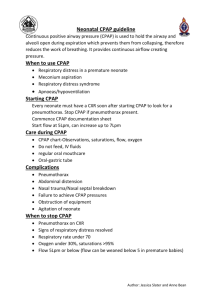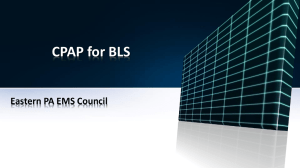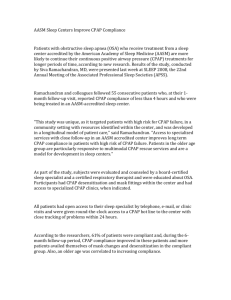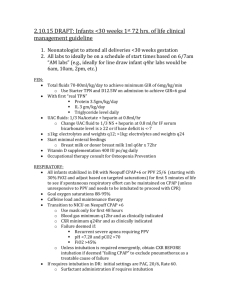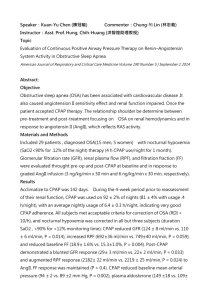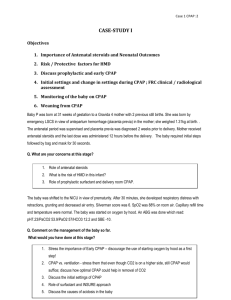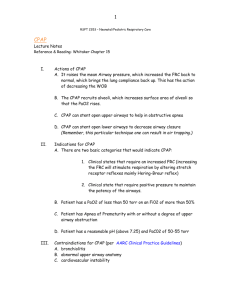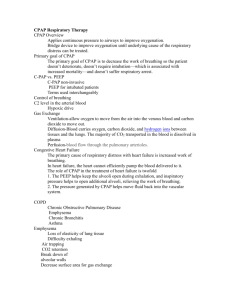CAP Module 2 - CPAP (GHEMS/DG_V2015)
advertisement
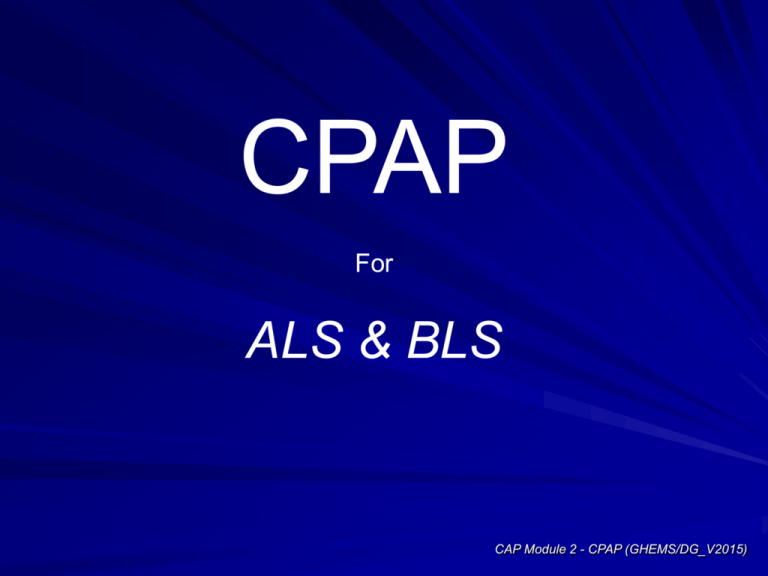
CPAP For ALS & BLS CAP Module 2 - CPAP (GHEMS/DG_V2015) CPAP Curriculum Introduction Review of Anatomy and Physiology CPAP Overview Pulse Oximetry Review of Respiratory Distress Treatment With CPAP CAP Module 2 - CPAP (GHEMS/DG_V2015) What is CPAP? Continuous Positive Airway Pressure (CPAP) A non-invasive alternative to intubation Does not require any sedation It provides comfort to the patient with acute respiratory distress by reducing work of breathing CAP Module 2 - CPAP (GHEMS/DG_V2015) Why CPAP? Respiratory Distress is a common reason why people call 911! Established therapeutic alternative Easily applied, easily discontinued CAP Module 2 - CPAP (GHEMS/DG_V2015) Key Points of CPAP CPAP has been successfully demonstrated as an effective adjunct in the management of a variety of respiratory distress states. CPAP may prove to be a viable alternative in many patients previously requiring endotracheal intubation by prehospital personnel. CAP Module 2 - CPAP (GHEMS/DG_V2015) CPAP vs. Intubation CPAP – – – – – Non-invasive Easily discontinued Easily adjusted Use by EMT-B Does not require sedation – Comfortable Intubation – Invasive – Usually don’t extubate in field – Potential for infection – Requires highly trained personnel – Can require sedation – Traumatic CAP Module 2 - CPAP (GHEMS/DG_V2015) Review of Anatomy & Physiology CAP Module 2 - CPAP (GHEMS/DG_V2015) Elements of the Airway UPPER AIRWAY Nares Nasopharynx Oropharynx Tongue Epiglottis/Glottis Vocal Cords LOWER AIRWAY Trachea/Esophagus Carina Main stem Bronchi Secondary Bronchi Bronchioles Alveoli CAP Module 2 - CPAP (GHEMS/DG_V2015) Upper Airway CAP Module 2 - CPAP (GHEMS/DG_V2015) Pharynx Nasopharynx – Uppermost portion of airway, just behind nasal cavities – Nasal septum – Vestibule – Olfactory membranes – Sinuses Oropharynx – Begins at the level of the uvula and extends down to the epiglottis – Opens into the oral cavity CAP Module 2 - CPAP (GHEMS/DG_V2015) Larynx Three main functions: – Air passageway between the pharynx and lungs – Prevents solids and liquids from entering the respiratory tree – Involved in speech production CAP Module 2 - CPAP (GHEMS/DG_V2015) Larynx An outer casing of nine cartilages – Thyroid cartilage – Cricoid cartilage Only complete cartilaginous ring in the larynx – Epiglottis Hyoid bone Cricothyroid membrane Vocal cords CAP Module 2 - CPAP (GHEMS/DG_V2015) Lower Airway CAP Module 2 - CPAP (GHEMS/DG_V2015) CAP Module 2 - CPAP (GHEMS/DG_V2015) Lungs Principal function is respiration Attached to heart by pulmonary arteries and veins Separated by mediastinum and its contents Base of each lung rests on the diaphragm Apex extends 2.5 cm above each clavicle CAP Module 2 - CPAP (GHEMS/DG_V2015) Pleural Cavity A separate pleural cavity surrounds each lung Two layers (visceral and parietal) Pleural space CAP Module 2 - CPAP (GHEMS/DG_V2015) Respiratory System Physiology The respiratory system functions as a gas exchange system Oxygen is diffused into the bloodstream for use in cellular metabolism CAP Module 2 - CPAP (GHEMS/DG_V2015) Respiratory System Physiology Wastes, including carbon dioxide, are excreted from the body via the respiratory system CAP Module 2 - CPAP (GHEMS/DG_V2015) Ventilation Ventilation refers to the process of air movement in and out of the lungs The volume of air moved in each breath is the tidal volume The volume still remaining in the chest after exhalation is the functional reserve capacity. FRC CAP Module 2 - CPAP (GHEMS/DG_V2015) Inspiration and Expiration Inspiration – Chest wall expands – Lung space increases – Pressure gradient causes gas to flow into the lungs Expiration – Chest wall relaxes – Elastic recoil causes thorax and lung space to decrease in size – Pressure gradient created in thoracic cavity causes air to move out of the chest CAP Module 2 - CPAP (GHEMS/DG_V2015) Pressure Changes During Inspiration and Expiration CAP Module 2 - CPAP (GHEMS/DG_V2015) Mechanics of Breathing CAP Module 2 - CPAP (GHEMS/DG_V2015) Mechanics of Respiration CAP Module 2 - CPAP (GHEMS/DG_V2015) Ventilation The following must be intact for ventilation to occur: – Neurologic control to initiate ventilation – Nerves between the brainstem and the muscles of respiration – Functional diaphragm and intercostal muscles – A patent upper airway – A functional lower airway – Alveoli that are functional and not collapsed CAP Module 2 - CPAP (GHEMS/DG_V2015) Diffusion In order for diffusion to occur, the following must be intact: – Alveolar and capillary walls that are not thickened – Interstitial space between the alveoli and capillary wall that is not enlarged or filled with fluid CAP Module 2 - CPAP (GHEMS/DG_V2015) How does CPAP work Splints the upper airway preventing collapse Uses continuous oxygen flow with pressure to push air into the lungs and push the fluid into the bloodsteam Recruits alveoli that have collapsed CAP Module 2 - CPAP (GHEMS/DG_V2015) CPAP Mechanism Increases pressure within airway. Airways at risk for collapse from excess fluid are stented open. Gas exchange is maintained Increased work of breathing is minimized CAP Module 2 - CPAP (GHEMS/DG_V2015) Pulse Oximetry Basic concept of Pulse Oximetry monitoring. – Objectively determines oxygenation status when applied correctly. – Measures the hemoglobin saturation in the bloodstream via red and infrared light, through the skin to the arterial bed. CAP Module 2 - CPAP (GHEMS/DG_V2015) Pulse Oximetry Possible invalid readings – Low blood flow states, (i.e., shock states, hypothermic, hypovolemia) may show an inaccurate low oxygenation percent. – Carbon monoxide poisoning may show a false high percent reading. – Anemias and oxygen capacity carrying diseases (i.e., sickle cell) may also show a false high reading. – Fingernail polish, excessive grease and dirt, nail-tips, or gel nails may cause a false low reading. CAP Module 2 - CPAP (GHEMS/DG_V2015) Review of Respiratory Distress CAP Module 2 - CPAP (GHEMS/DG_V2015) Respiratory Distress Work of Breathing – Respiratory rate greater than 25/minute – The presence of retractions and/or use of accessory muscles Appearance = Mental Status – Pulse Oximetry < 94% – Effects of hypoxia and hypercarbia indistinguishable Circulation/Skin Color – Severe cyanosis – Pallor and diaphoresis CAP Module 2 - CPAP (GHEMS/DG_V2015) Primary Assessment Ascertain the patient’s chief complaint that may include: – Dyspnea – Chest pain – Cough Productive Non-productive Hemoptysis – Wheezing – Signs of infection Fever, chills Increased sputum production CAP Module 2 - CPAP (GHEMS/DG_V2015) History Previous experiences with similar/identical symptoms Known pulmonary diagnosis Medication history – – – – Current medications Medication allergies Pulmonary medications Cardiac-related drugs History of the present episode Exposure and smoking history CAP Module 2 - CPAP (GHEMS/DG_V2015) Secondary Assessment • • • • • • • • Lung Sounds Work of Breathing - including Rate Chest Wall Movement Pulse Oximetry Skin Color Vital Signs Level of Consciousness Associated Symptoms CAP Module 2 - CPAP (GHEMS/DG_V2015) Pulmonary Edema – Congestive Heart Failure Defined – Fluid which collects in the lung tissue and alveoli Signs/Symptoms/Assessment – Anxious, Pale, Clammy, Dyspnea, Tachypnea, Confusion, Edema, Hypertension, Diaphoretic – Rales, Ronchi, Tachycardia, JVD, Pink Frothy Sputum, Cyanosis CAP Module 2 - CPAP (GHEMS/DG_V2015) Pulmonary Edema – Congestive Heart Failure Signs/Symptoms/Assessment – Fatigue – Nocturia – Dyspnea on exertion – Paroxysmal nocturnal dyspnea – Chest Pain – Orthopnea CAP Module 2 - CPAP (GHEMS/DG_V2015) Pulmonary Edema – Congestive Heart Failure Treatment – Focused history and physical exam – Complains of trouble breathing. Airway control w/ adequate ventilation Oxygenation – Has a prescribed nitroglycerine available. Consult medical direction. Facilitate administration of nitroglycerine – Baseline vital signs. – Reassess CAP Module 2 - CPAP (GHEMS/DG_V2015) Chronic Obstructive Pulmonary Disease (COPD) Defined – Lung tissue loses elasticity secondary to destruction of the alveoli (Emphysema) – Inflammation of the bronchial tree. Diagnosed by productive cough which lasts at least three months a year for at least two consecutive years (Chronic Bronchitis) – Any COPD patient may have both CAP Module 2 - CPAP (GHEMS/DG_V2015) Chronic Obstructive Pulmonary Disease (COPD) Signs/Symptoms/Assessment – – – – – – – – Exertional dyspnea Productive cough/wheezing Minor hemoptysis Tachypnea/exertional muscle use Pursed lip exhalation May have coarse crackles Accessory muscle use Hyperexpansion of the thorax (diminished breath sounds) – Excessive caloric expenditure CAP Module 2 - CPAP (GHEMS/DG_V2015) Chronic Obstructive Pulmonary Disease (COPD) Signs/Symptoms/Assessment – Tachypnea, cyanosis, agitation, tachycardia, hypertension – Confusion, tremor, stupor, apnea CAP Module 2 - CPAP (GHEMS/DG_V2015) Chronic Obstructive Pulmonary Disease (COPD) Treatment – Focused history and physical exam – Complains of trouble breathing. Airway control w/ adequate ventilation Oxygenation – Has a prescribed inhaler available. Consult medical direction. Facilitate administration of inhaler Repeat as indicated. – Baseline vital signs. – Reassess CAP Module 2 - CPAP (GHEMS/DG_V2015) Asthma Defined – Condition which causes the bronchi to constrict making it difficult to exhale (air trapping) – May be caused by allergic reactions and/or emotional distress – The most serious form, status asthmaticus, is a true life-threatening emergency CAP Module 2 - CPAP (GHEMS/DG_V2015) Asthma Signs/Symptoms/Assessment – Dyspnea, chest tightness, wheezing, and cough – Obvious SOB, wheezing, accessory muscle use, paradoxical respirations, hyperresonance, prolonged expiration – Change in Mental Status: agitation, confusion, lethargy, exhaustion – Cardiac Arrhythmias CAP Module 2 - CPAP (GHEMS/DG_V2015) Asthma Treatment – Focused history and physical exam – Complains of trouble breathing. Airway control w/ adequate ventilation Oxygenation – Has a prescribed inhaler available. Consult medical direction. Facilitate administration of inhaler Repeat as indicated. – Baseline vital signs. – Reassess CAP Module 2 - CPAP (GHEMS/DG_V2015) Pneumonia Defined – Inflammation of both the bronchioles and alveoli – May be viral, bacterial, or fungal. Spread by droplets or contact with infected person – Common cause of death in North America CAP Module 2 - CPAP (GHEMS/DG_V2015) Pneumonia Signs/Symptoms/Assessment – Acute onset of chills, fever, dyspnea, pleuritic chest pain, cough, adventitious breath sounds. – In geriatric patients, the primary sign may be an altered mental state. CAP Module 2 - CPAP (GHEMS/DG_V2015) Pneumonia Treatment – Focused history and physical exam – Complains of trouble breathing. Airway control w/ adequate ventilation Oxygenation – Has a prescribed inhaler available. Consult medical direction. Facilitate administration of inhaler Repeat as indicated. – Baseline vital signs. – Reassess CAP Module 2 - CPAP (GHEMS/DG_V2015) Treatment with CPAP CAP Module 2 - CPAP (GHEMS/DG_V2015) CPAP System Goal of CPAP To have an effective way to treat CHF/Pulmonary Edema Provide high flow/low pressure oxygenation Reduce the number of intubations in the field CAP Module 2 - CPAP (GHEMS/DG_V2015) CPAP System The three components of CPAP Pressure – The most important component – Average adult should receive 7.5-10 cmH2O (some pts. require more…) – Pressure is the key to CPAP being effective Flow – Second in importance – The more flow, the better…patients want the “windtunnel” in their face. FiO2 – Least important – High % of oxygen is not what the CHF pt. needs. CAP Module 2 - CPAP (GHEMS/DG_V2015) CPAP System Two models available Fixed flow generator Variable flow generator CAP Module 2 - CPAP (GHEMS/DG_V2015) CPAP System Fixed (GHEMS BLS) NO knobs to manipulate Simple -No Moving Parts -No flapper valve to restrict flow Durable -No maintenance problems Flow approximately 140 liters/min. Concentration at 30% FIO2 CAP Module 2 - CPAP (GHEMS/DG_V2015) CPAP System Variable (GHEMS ALS) Three independent controls On/Off Flow Rate – up to 140 liters/min. Highest available FIO2 – 30% to 100% Broadest range available CAP Module 2 - CPAP (GHEMS/DG_V2015) CPAP System Patient Circuit Complete Package includes 1. Mask 2. Tubing 3. Head Strap 4. CPAP Valve 5. Air entrainment filter CAP Module 2 - CPAP (GHEMS/DG_V2015) CPAP System Seal-Flex Mask 1. Comfortable cushion “inflates” with minimal pressure 2. Leak tolerant - no need for excessive force to seal mask 3. Anti-asphyxia valve on mask - may be used to verify proper flow 4. One way valve at base - prevents back flow 5. May be used as a resuscitation mask CAP Module 2 - CPAP (GHEMS/DG_V2015) CPAP System Tubing 7 feet Has break points From CPAP Generator to CPAP Valve Head Strap 3 or 4 point strap CAP Module 2 - CPAP (GHEMS/DG_V2015) CPAP System CPAP Valve GHEMS… – 10 cm H2O – 5 cm H2O Goes on front of Mask Can be “stacked” CAP Module 2 - CPAP (GHEMS/DG_V2015) CPAP System Air entrainment filter CAP Module 2 - CPAP (GHEMS/DG_V2015) CPAP System Oxygen Source CAP Module 2 - CPAP (GHEMS/DG_V2015) CPAP System Low Oxygen Consumption Fixed uses 13 lpm of oxygen 13 lpm O2 (less than a standard non-rebreather) 127 lpm entrained room air (21% FIO2) 140 lpm total flow Same flow rate for Variable at initial settings CAP Module 2 - CPAP (GHEMS/DG_V2015) CPAP System Tank Duration Approximate time at 30% FIO2 D 33 min. E 50 min. M 253 min. H 508 min. CAP Module 2 - CPAP (GHEMS/DG_V2015) CPAP System Two type of CPAP generators 1) Constant Flow Meets the true definition of Continuous Positive Airway Pressure Prevents the need for the patient to initiate flow Lowers the work of breathing 2) Alternate Flow (Demand Type) Alternates between positive pressure flow and PEEP CAP Module 2 - CPAP (GHEMS/DG_V2015) CPAP System Advantages of true CPAP A stable airway pressure as prescribed to reduce the work of breathing (WOB) Higher flow rate to ensure continuous positive airway pressure (140 lpm vs. 100 lpm) Patient does not have to initiate flow from the device – Reduces patient anxiety – Increase patient comfort and compliance FIO2 from 30% up to 100% Lower oxygen consumption CAP Module 2 - CPAP (GHEMS/DG_V2015) Treatment With CPAP Indications – – Any patient who is in respiratory distress with signs and symptoms consistent with: Congestive Heart Failure (CHF), Pulmonary Edema, COPD, Near Drowning Other measures to improve oxygenation and decrease the work of breathing have failed (i.e., 100% O2 via NRM). CAP Module 2 - CPAP (GHEMS/DG_V2015) Treatment With CPAP Indications (con’t) – And who is: Awake and able to follow commands Is >12 years old and able to fit CPAP mask Has the ability to maintain an open airway Exhibits two or more of the following: –RR > 25 BPM –SPO2 < 94% at any time –Use of accessory muscles of breathing CAP Module 2 - CPAP (GHEMS/DG_V2015) Treatment With CPAP Contraindications – – – – – – – Significant Facial Hair Patient is apneic Pneumothorax is suspected Patient is trauma patient with injury to the chest Patient has a tracheostomy Patient is actively vomiting or has upper GI bleeding Patient has intolerance for CPAP mask or procedure. (ALS personnel may use Versed 2mg to 5mg to facilitate patient compliance with procedure.) CAP Module 2 - CPAP (GHEMS/DG_V2015) Treatment With CPAP Procedure – – – – – – EXPLAIN THE PROCEDURE TO THE PATIENT Place patient on continuous pulse oximetry Position head of patient at 45 degrees or patient position of comfort With device operating, place mask on patient and secure with straps Use CPAP valve of 10 cm H2O for most patients (adult and pediatric). In extreme cases 15 cm H2O can be utilized. For variable flow generators Use an initial setting of 30% FiO2 at a flow rate of 140 liters/min., increase FiO2 PRN. CAP Module 2 - CPAP (GHEMS/DG_V2015) Treatment With CPAP Procedure (cont.) – Check for air leaks around face/mask interface. Readjust as needed – Coach patient to breathe with device – Request ALS intercept. ALS shall consider appropriate drug therapy as adjunct May use small amounts of Versed if the patient does not tolerate mask. Use Morphine to reduce preload in CHF patients. – If respiratory status deteriorates, remove device and assist ventilations w/ BVM – ALS personnel should consider intubation (follow RSI protocol). CAP Module 2 - CPAP (GHEMS/DG_V2015) Treatment With CPAP Patient improvement indicated by: – Improvement in dyspnea – Decreased respiratory rate – Improved pulse oximetry – Improved patient comfort CAP Module 2 - CPAP (GHEMS/DG_V2015) Treatment With CPAP Removal – CPAP needs to be continuous and should not be removed unless the patient cannot tolerate the mask or experiences respiratory arrest and/or begins to vomit – Do not remove CPAP until hospital therapy is ready CAP Module 2 - CPAP (GHEMS/DG_V2015) Treatment With CPAP Special Considerations – Watch for gastric distention which can cause vomiting – Use extreme caution in patients with endstage COPD: Consider 5 cm H2O as initial pressure – CPAP may be used with patients who have POLST forms or DNR orders CAP Module 2 - CPAP (GHEMS/DG_V2015) Thank You Questions? CAP Module 2 - CPAP (GHEMS/DG_V2015)
